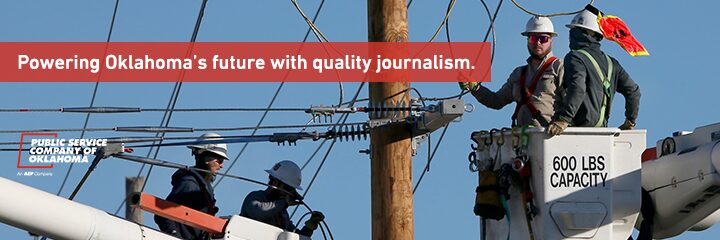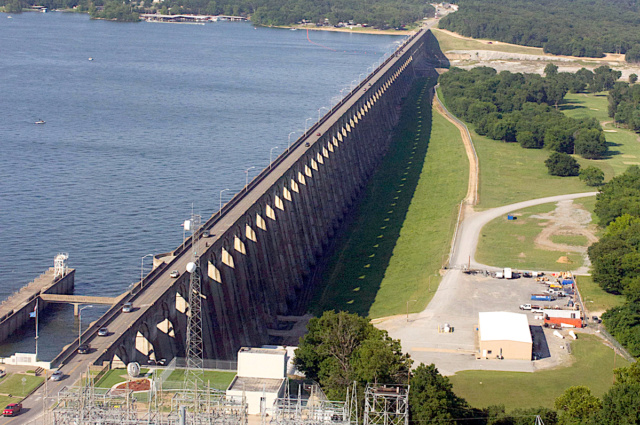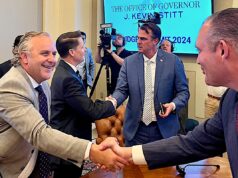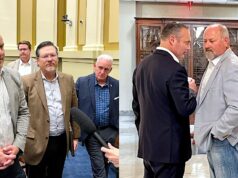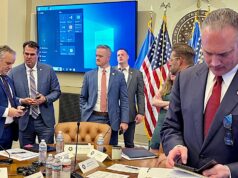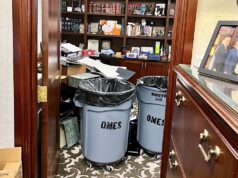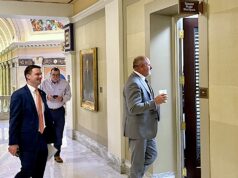Oklahoma’s Economic Development Generating Excellence (EDGE) committee was formed by former Gov. Brad Henry to come up with ideas for our state’s government.
In September 2003, I suggested to the EDGE committee that Oklahoma could create a $1 billion EDGE endowment. At the time, the committee was focused on developing Oklahoma’s business climate.
This idea for a $1 billion endowment became the cornerstone of the EDGE committee’s recommendations and was intended to fund infrastructure and scientists who could attract research dollars from a variety of sources. The program would take advantage of the federal government’s often-significant match in such funding. The hope was to create an upward spiral where more scientists meant more funding and the commercialization of new discoveries leading to the creation of new businesses.
I recommended selling state assets that were either underused or simply outside the scope of normal state government activities to create this $1 billion fund. The plan was lauded as a wonderful idea — until all the special interests who were associated with the suggested assets to be sold caused the EDGE committee and Gov. Henry to decide that state appropriations should fund this endowment instead.
This produced tepid and insignificant results, and the $1 billion EDGE endowment is resting comfortably on a dusty shelf.
Oklahoma has now managed to willfully bankrupt itself by dramatically reducing taxes, primarily on the oil and gas industry, and then blaming the loss of revenue on the decline of oil and gas prices. These irresponsible state government actions reduced an already paltry funding stream for Oklahoma’s essential services and responsibilities — such as education, health care and public safety. As a result, there may be a new audience and motivation to stare down the special interests and “monetize” those assets that are not doing the state any good in their current form.
Chicago Mayor Rahm Emanuel, former chief of staff for the Obama White House, said about the 2008 financial crisis, “You never want to let a serious crisis go to waste.”
Now may be the time for a new $1 billion EDGE fund. Perhaps it could be called the Education Development Generating Excellence fund this time around.
How to find $1 billion
A lack of financing and monetary resources is simply not a good excuse for avoiding the pursuit of good projects and programs. There is always money for good deals. One way to find such money would be for Oklahoma to monetize unproductive assets.
Have you ever seen the balance sheet for the state of Oklahoma? Ask a legislator or a governor or an economist, and their answer will be a hesitant no. State leaders and the media spend a lot of time on our income statement. (In fact, we are obsessed with our immediate revenue and our immediate expenses, and the ups and downs of these amounts consume massive amounts of time and effort.)
But no one ever talks about the balance sheet. What do we own as a state? Should we own these things? Are all of our “assets” a priority? Can they be sold and “monetized”? Can some be sold and leased back to the mutual advantage of both the buyer and the state? How do we specifically identify these assets?
The governor and the Legislature should form an independent group of business and state leaders whose task it would be to create and refine a balance sheet for the state. This Balance Sheet Commission, likely numbered in the range of 50 people, should have capable co-chairs who form five 10-member sub-committees so that significant work can occur simultaneously.
The Balance Sheet Commission should frankly be dominated by business leaders, and the co-chairs of the commission should raise privately the money necessary to fund the Balance Sheet Commission operations so that it can be completely independent and not use any precious and limited state resources.
That would also allow the commission to start faster and work more efficiently. Outside of a periodic report to the governor and legislative leaders, this group should be able to get its work done in six months. Their goal should be to present some target assets for consideration by our state leaders for “monetization.”
Some dam examples
Without prejudging the work of the Balance Sheet Commission, the following examples are provided to add some color to this overall suggestion and allow it to be understood more quickly. Some possible options:
The Grand River Dam Authority is essentially an electric utility and has billions of dollars of assets and debt. It is “owned” by the state. Most third-world countries have privatized their electrical power facilities, so why is Oklahoma operating a full-scale utility when there are so many private and regulated businesses doing the same thing? A review of the GRDA financial statements suggests that there are millions, perhaps hundreds of millions, of dollars of equity in the GRDA. The net worth of the GRDA is listed in their 2015 year-ending financial report as $594,503,372.
The GRDA financial performance is terrible, which one might argue is related to its state ownership and the inefficiencies that such political and bureaucratic operations naturally bring to a fast-paced industry. Remember the state-owned lodges? The GRDA currently makes about 1 percent return on $1.9 billion in assets. It makes only 3.3 percent on the net position cited above.
Recall that regulated utilities in Oklahoma are allowed to make 9 to 10 percent on their assets. So GRDA should be a rich target in which a regulated utility or a private utility conglomerate or a huge hedge fund will know that they can streamline operations, sell unproductive and antiquated assets and finance new, modern assets, including renewables. As a result, profitability could dramatically improve for the GRDA.
What about the GRDA employees, you might ask? They will all make more money when they are not state employees, including the management, which is not paid anywhere close to what utility executives earn. Part of the transaction would be that any employees released would have an attractive “golden parachute” provided. The fact is, however, that in private hands GRDA will grow faster and more likely prosper, so it is much more likely that jobs will be created rather than lost.
What about GRDA’s management of Grand Lake? This task — which often times takes more time from the management and Board of Directors of GRDA than running a multi-billion company takes — can be segregated and turned over to a separate commission or agency that can spend endless hours arguing about docks and other lake-management issues.
And what about GRDA’s purpose to offer low-cost power? Here is a secret: GRDA’s power essentially costs the same as everyone else’s. Back in the day, when Franklin Roosevelt formed the TVA, organizations like the GRDA had some modicum of justification for being government-owned. Now, however, we have a multi-state Southwest Power Pool into which all utilities sell and purchase their power. So we have a common and competitive and highly efficient market, which has eliminated the need for governments to own utilities directly.
So, the sale of the GRDA would likely generate somewhere between $500 million to $1 billion for the proposed new EDGE endowment. It would pay its employees more, protect anyone that loses a job, create more jobs, better manage Grand Lake and charge the same for power as other utilities.
Another asset ripe for sale would be the Mid-America Industrial Park, which is known to few Oklahomans and is a somewhat unusual asset. However, the last time I checked their cash account, they had about $100 million in the bank. They own a sizable industrial park in Pryor, Oklahoma, and they are owned by the state.
In a particularly bizarre wrinkle the director of this organization serves for life. Put another way, the director of the Mid-America Industrial Park and the Pope serve until they die. Anyway, I digress.
You might be asking yourself why Oklahoma owns an industrial park with $100 million of cash in the bank and ownership of at least another $50 to $100 million of land and buildings. Good question. It is a prime target to be sold to an industrial park developer who can take advantage of depreciation and private ownership efficiencies, begin paying local property taxes to create a big influx into local schools AND put $200 million in a new education fund.
Real estate and buildings
The state also owns numerous buildings and pieces of real estate. When owned by a government, those properties do not pay taxes and therefore have no use for depreciation, which is a major part of the returns that private owners and developers enjoy.
Governments are also typically inefficient managers because of political regulation and rules that private businesses avoid. There is a reason that so many state agencies are located in private facilities: They pay very low rents to owners who still manage to make a living, but do not pay enough rent to defray the cost to build and operate state-owned buildings.
Now, neither Harold Hamm nor George Kaiser should own the State Capitol, but the state owns land and buildings in every county of Oklahoma. In many cases, a sale with a lease back would make a local developer money and save the state money, with lower effective rents compared to what the state is paying to maintain and operate the buildings.
Finding and analyzing these land parcels and buildings should be the subject of a Balance Sheet Subcommittee, with strong representation from the real estate industry. If one were to add up the state’s unused land and buildings along with those state buildings that would be cheaper to lease back than to own, there may be as much as a few million square feet, and the state would realize about $200 to $300 million by cleaning up and monetizing its real estate ownership.
This estimate does not include any of the holdings of the Commissioners of Land Office. I won’t dwell on this, but that group controls 750,000 acres of land in Oklahoma. If you apply a current market value to that land and then see how much Oklahoma makes leasing this land — which is fraught with bureaucracy — we would quickly realize that if the land was sold and invested in T-bills, the state would make more money than it does now. There is at least $500 million to $1 billion worth of value here. I have not included this land as a target asset because its net proceeds, meager as they are, generally benefit schools already.
However the Balance Sheet Commission should have a subcommittee analyze this carefully, and what they will conclude is that rather than a Commissioners of Land Office, we should instead have a Commissioners of a Giant Investment and Portfolio Office.
A (former) state insurance company
CompSource Mutual is an insurance company, not to be confused with the state agency that regulates insurance companies. This company is owned by its policyholders, which used to include the state. In 2003, it was estimated that the state had about $100 million of value in this company, however, in 2015, Oklahoma decided to self-insure. Instead of withdrawing and retaining their share of the claims reserves and the surplus — worth more than $100 million — the state simply left the group, and I assume erroneously forfeited this value.
Today, Oklahoma’s share of the cash surplus and the reserves (combined totaling more than $1.8 billion) would be more than $200 million. I mention this in case some enterprising legislator who is smarter than the state officials who forfeited this money could carefully review and confirm that Oklahoma has forever given up its share of this $1.8 billion amount of surplus and reserves for nothing.
Broad estimates show promise
So the range of the “guesstimates” above is $850 million to $1.5 billion. If the very broad estimates above are way off — and there is only half the value estimated — this would still generate a $500 million contribution to an EDGE endowment. And who knows what else might come up after the independent business-oriented Balance Sheet Commission provides its report?
There are likely to be many other good funding ideas. If education would benefit from the EDGE fund, then perhaps the lottery proceeds could be deposited in the EDGE endowment rather than spent completely every year. Imagine in 25 years what Oklahoma education would have. How about every time oil and gas prices spike and the state has a windfall, rather than pretending to be drunken sailors and spending it all or giving it back to the oil companies as was done recently, perhaps the funds could be in part deposited in the EDGE fund.
The point is that if the state wants to put together monetary resources to create a huge fund to support education, it will be complicated, politically difficult and controversial … but possible.
Imagine a $1 billion endowment that would be working away, earning interest 100 years from now. This EDGE endowment could provide the resources to educate our children at a level above that which we can now afford.
Such a distinctive, focused effort would counter the negative impressions created by Oklahoma’s willful bankruptcy, and it would begin to move the state’s economy in a futuristic direction.
(Editor’s note: The author is the president of an international power company, and he owns commercial real estate, some of which is leased by Oklahoma state agencies.)
